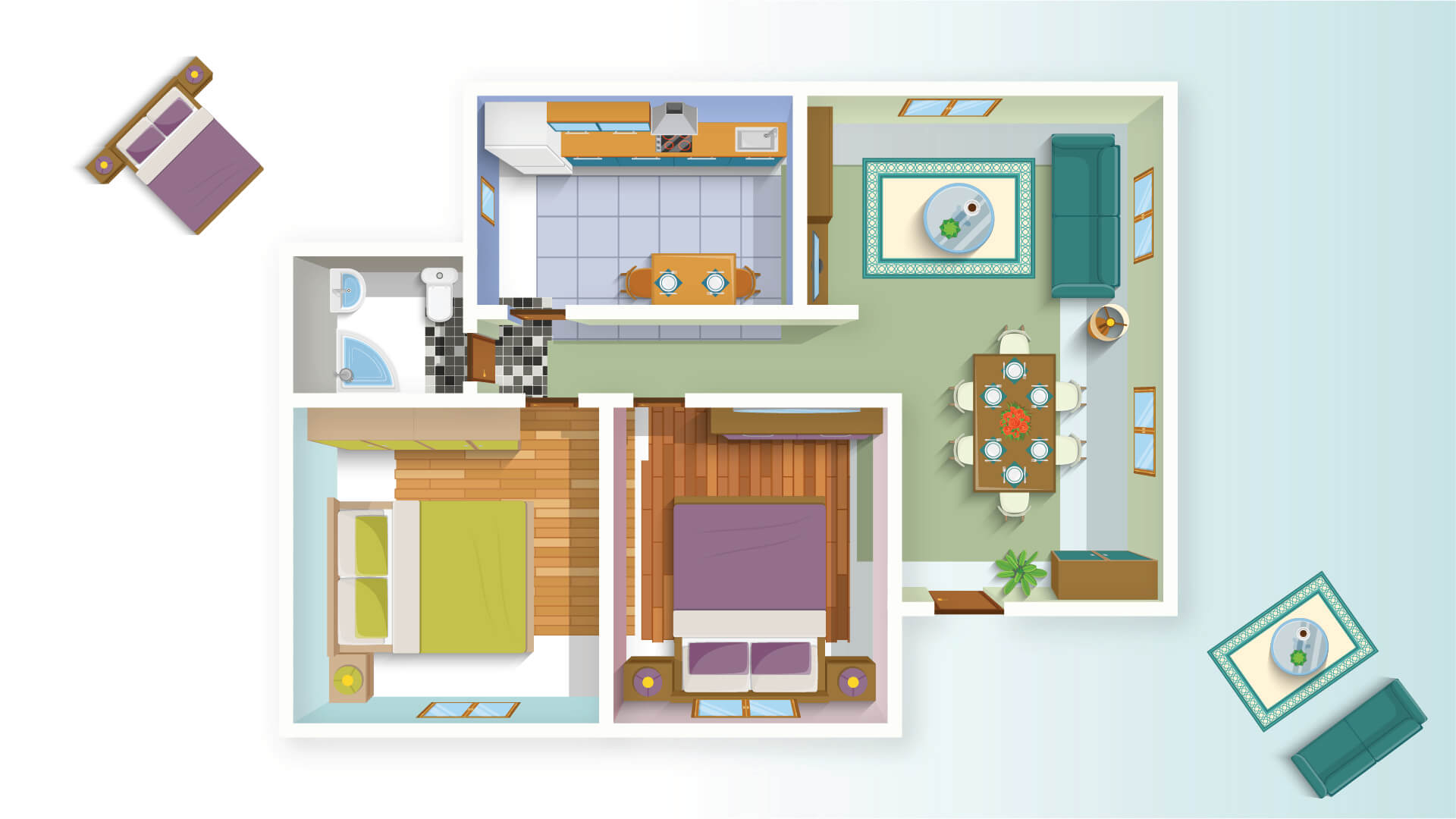Table of content
- Introduction
- What is Carpet Area?
- What is included in the carpet area and what is not?
- What is RERA Carpet Area?
- What is the Difference Between RERA Carpet Area and Carpet Area?
- What is Usable Area?
- What Should Homebuyers Consider: RERA Carpet Area vs Usable Area?
- So, what’s the takeaway here?
- What is Built-Up Area & Super Built-Up Area?
- What is Loading Factor?
- How to Calculate the Loading Factor?
- What is Undivided Share (UDS)?
- Why is UDS Important?
- Essential Guidelines for Homebuyers
- Conclusion>
Introduction
You’ve been exploring listings and visiting experience centers, searching for your dream home. But those real estate terms agents throw around can feel like a whole new language, right? You know “super” from Superman, but now they’re talking about “super-built up area” and “carpet area.” Puzzled? Don’t worry—we understood the assignment. This blog will help you decode the real estate jargon, so you can confidently visit experience centers, understand brochures, and find a home that truly meets your needs—without getting misled.
What is Carpet Area?
Carpet area also known as the usable carpet area means simply the space within the apartment/villa where you can lay down a carpet or arrange your furniture. So in real estate when someone uses the word carpet area it means the space available in the apartment for your personal use and it excludes walls, balcony and terrace. To calculate this area, measure the length and width of the room from wall to wall and multiply those measurements.
Here’s a simple example:
If a room measures 12 feet in length and 10 feet in width, you would calculate the carpet area as follows:
- Length : 12 feet
- Width : 10 feet
Carpet Area = Length × Width = 12 feet × 10 feet = 120 square feet
So, the carpet area of this room is 120 square feet, which represents the usable space within the inner walls.
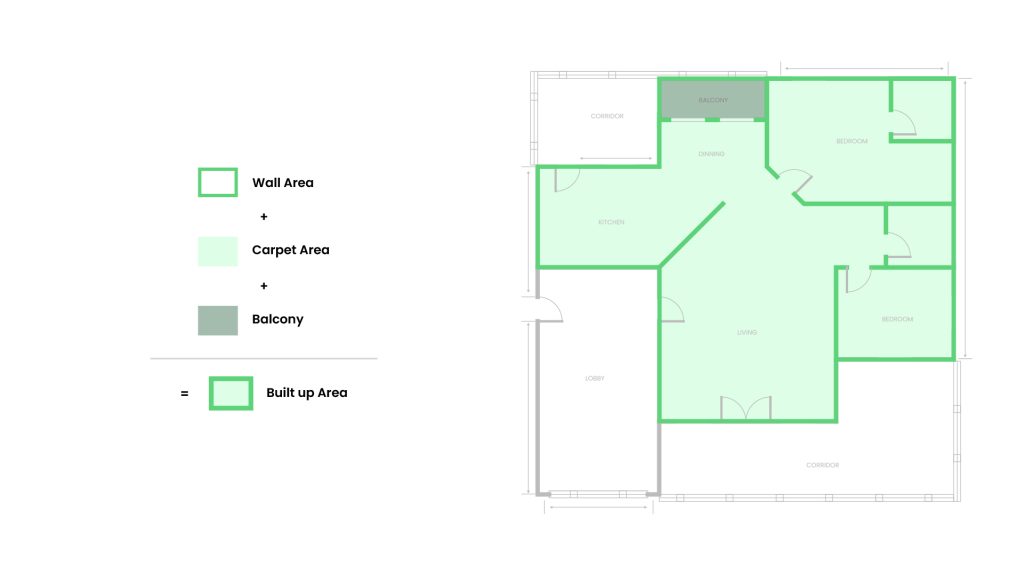
What is included in the carpet area and what is not?
Included :
- Kitchen
- Bathrooms
- Rooms (bedrooms, living rooms, dining rooms etc.)
- Staircases within the property (if applicable)
Excluded:
- Balcony/private balcony
- Shared spaces or common areas (like hallways and lobbies)
- Utility ducts
- walls.
What is RERA Carpet Area?
So according to RERA, it’s the “net usable floor area of an apartment,” so it excludes external walls, service shaft areas, and private balconies or terraces. But the only difference is that—it includes the area covered by the internal partition walls of your apartment.
RERA Carpet Area = Net Usable Area of the Apartment(excluding external walls, terrace, balcony, and verandah) + Internal Partition Wall Areas.
What is the Difference Between RERA Carpet Area and Carpet Area?
The main distinction between the RERA Carpet Area and general Carpet Area (Usable Carpet Area) lies in the treatment of internal partition walls. RERA Carpet Area includes the thickness of these internal walls, whereas the general Carpet Area does not. As a result, RERA Carpet Area is typically about 5% larger than general Carpet Area.
What is Usable Area?
Usable Area ( Carpet Area + Balcony/ Terraces) refers to the functional space within your home that you can truly live in and enjoy. It goes beyond just the primary rooms like bedrooms, living areas, and kitchens, capturing those valuable extras, such as:
-
Balconies :
Your personal outdoor retreat, ideal for a breath of fresh air right off the living room.
-
Terraces :
A versatile space, perfect for relaxing, cultivating a garden, or hosting gatherings under the stars.
What Should Homebuyers Consider: RERA Carpet Area vs Usable Area?
When you’re on the journey of buying a home, it’s super important to grasp the difference between RERA carpet area and usable area. Think of the RERA carpet area as a useful guideline—it gives you a sense of how much space you’re working with. However, it doesn’t always show you the actual usable space in your apartment.
While the RERA carpet area gives you a standardized measurement, don’t forget to consider the usable area, which might include those lovely balconies and other practical living spaces. So, when you’re checking out a home, remember to look at the usable area. It gives you a better idea of how much space you really have for your daily life and all the activities you enjoy!
So, what’s the takeaway here?
As a homebuyer, you should really focus on the usable area when evaluating properties. Sure, the RERA carpet area is important for understanding regulations, but looking at the usable carpet area gives you a clearer idea of what you’ll actually have to enjoy in your new home.
To get a good sense of the usable carpet area, take some time to measure and total up all the spaces inside your flat. This way, you’ll have a solid understanding of the living space available to you, making your home-buying experience much more informed and satisfying!
Now that you understand what carpet area and RERA carpet area mean, let’s move on to another set of commonly used terms in real estate: built-up area and super built-up area. Ready?
What is Built-Up Area & Super Built-Up Area?
Even though RERA doesn’t use these for pricing anymore, understanding them can be beneficial.
-
-
Built-Up Area :
The built-up area is the total space within a property’s walls, including the carpet area and wall thickness. It covers the carpet area plus spaces taken up by exterior walls and is also called the “plinth area.”
It includes the carpet area, walls, balconies and is usually about 10-20% more than the carpet area due to wall thickness and shared areas.
-
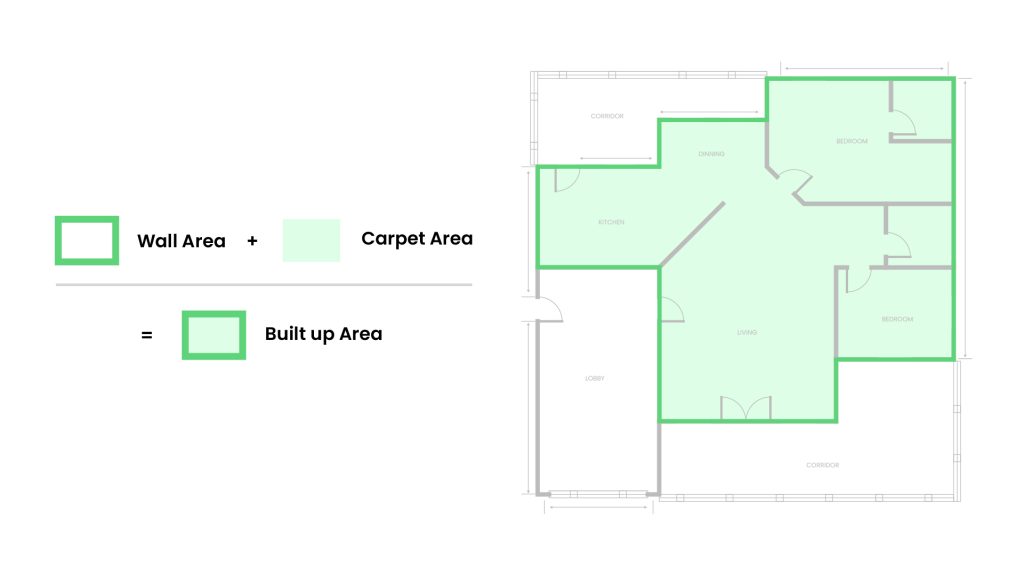
-
Super Built-Up Area :
This is referred to as the “saleable area” which includes your living space plus shared areas like common corridors, lifts, and clubhouses. This takes the built-up area a step further by including common spaces like lifts, staircases, and amenities such as clubhouses and swimming pools.
However, it excludes areas like compound walls, open-air swimming pools, parks, driveways, open sports facilities, inaccessible garden spaces, play areas, underground tanks, water reservoirs, and septic tanks. It’s typically 25-30% more than the built-up area.Example: If the Carpet Area is 1500 sq. ft.
RERA Carpet Area will be Approximately 1575 sq. ft.
Built-Up Area: Around 1650-1800 sq. ft.
Super Built-Up Area: Typically ranges between 2062.5 and 2340 sq. ft. (assuming a 30% increase).
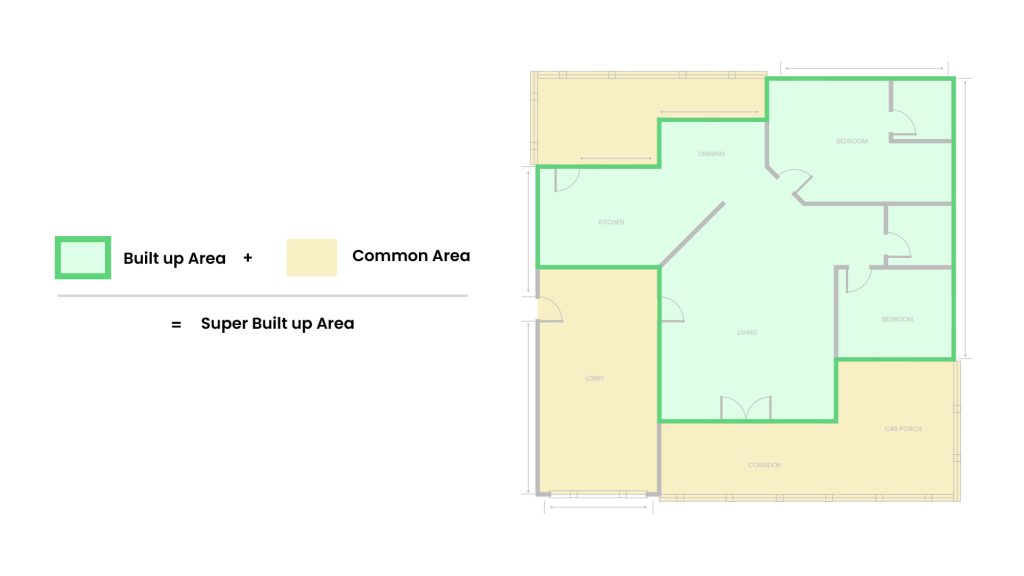
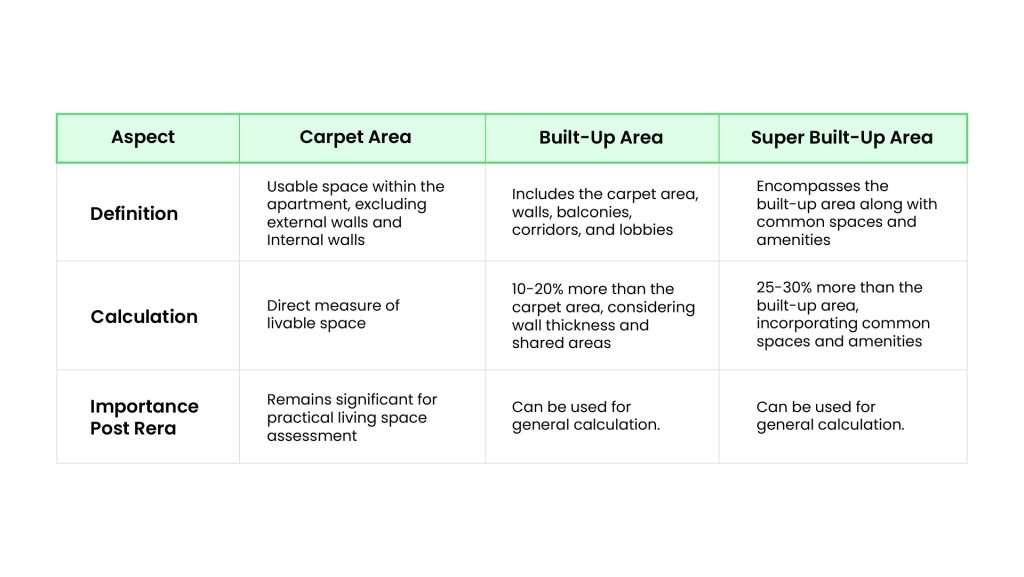
What is Loading Factor?
The difference between the super built-up area and the carpet area is called the Loading Factor. This accounts for shared spaces like elevators, the lobby, and amenities that aren’t exclusive to your home.
How to Calculate the Loading Factor?
Here’s a simple formula: Super Built-Up Area = Carpet Area × (1 – Loading Factor) For example, if the loading factor is 0.3 (or 30%), that means 30% of the super built-up area is common space.
What is Undivided Share (UDS)?
When you buy an apartment in a residential complex, you also acquire an undivided share of the land (UDS) on which the entire building stands. This UDS doesn’t have specific boundaries but represents your portion of the overall property, similar to being a shareholder in a company.
Why is UDS Important?
The total apartment cost typically includes both the building structure and the land, with the land cost tied to your UDS. If the property undergoes redevelopment or is acquired by the government, your compensation is calculated based on your UDS. Furthermore, if you receive a designated parking space, this land allocation is added to your UDS, so be sure the developer registers the parking space in your name to ensure hassle-free ownership benefits.
Essential Guidelines for Homebuyers
-
Do Your Market Research :
Before diving into negotiations, take some time to research the current market rates for properties of similar size and location. Check This knowledge will give you a solid foundation for determining a fair price related to the carpet area, built-up area, and super built-up area.
-
Request Detailed Floor Plans :
Don’t hesitate to ask the builder or developer for detailed floor plans that outline the layout and dimensions of each room, including wall thickness. This information will allow you to independently calculate the carpet area, built-up area, and super built-up area, ensuring you’re getting a fair deal.
-
Ask for a Cost Breakdown :
To gain clarity on how costs are calculated, request a detailed breakdown from the builder or developer for the carpet area, built-up area, and super built-up area. This approach will help you understand the complete cost structure of the property, including any additional charges or fees that may apply.
Modern Spaaces, like other reputed builders, provides detailed information about floor plans that helps buyers make decisions confidently.
Conclusion.
Knowing terms like carpet area, loading factor, and the difference between built-up and super built-up areas equips you to make informed decisions during your home-buying journey. It empowers you to compare properties accurately, assess usable living space, and ensure you get the space that meets your needs. By understanding these terms and leveraging the protections offered by RERA, you can buy your dream home with confidence!
Ready to find your ideal RERA-certified and spacious home? Visit www.modernspaaces.com or contact us at +91 900 800 67 68 today!
Read our Latest Blogs

Rise of Women homeowners: Why are they turning towards real estate?
Author: Vinay Gurudutt
- May 13, 2025
- 19 min read

Spotlight on Modern Spaaces
Author: Vinay Gurudutt
- May 13, 2025
- 4 min read
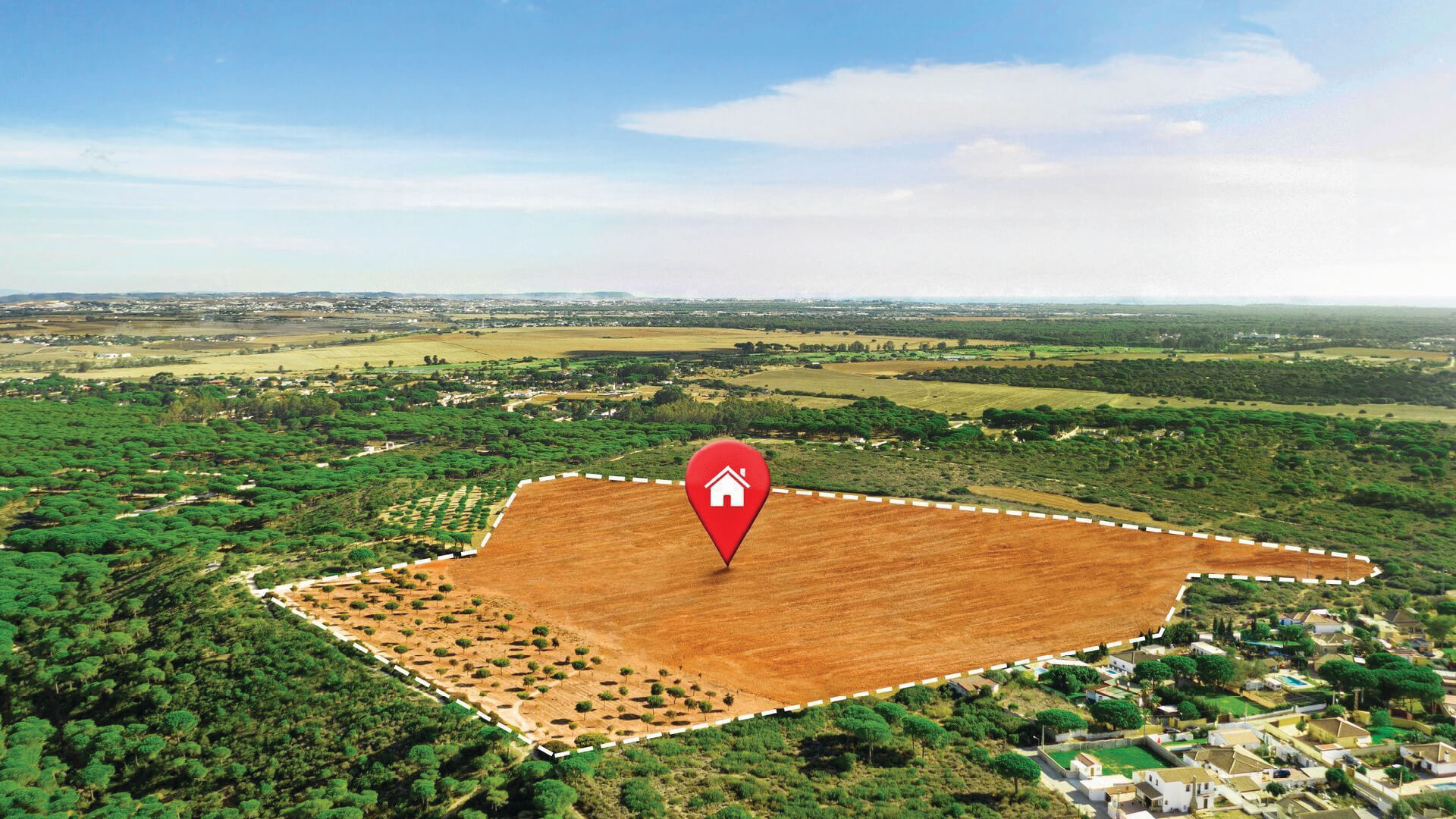
Build Your Dream Home: The Benefits of Plotted Developments
Author: Vinay Gurudutt
- May 13, 2025
- 11 min read
Explore Projects

The True 3 BHK
starts @ 1.55 Cr
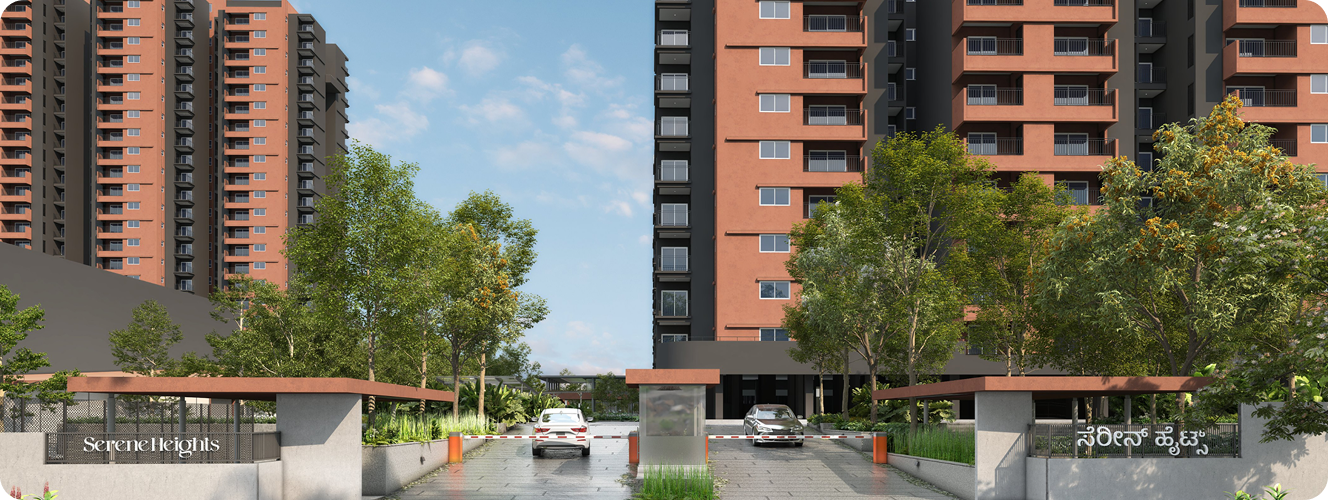
Multi-Gen 2 & 3 BHK Homes
Starts @ 1.4 Cr

Pristine Villa Plots
starts @ 1.15 Cr
Refer & Earn Up to 2%

Invite your friends to discover Modern Spaaces and earn up to 2% of the home value they buy.
Find your Dream Home. Let's talk
Tell us a bit about what you're looking for. One of us will get back to you!
